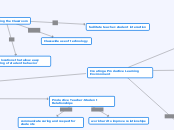Creating a Productive Learning Environment
Creating a Setting Conducive to Learning
Classroom Management
Students are consistently engaged in productive learning
Similar to authoritative parenting
Effective Classroom Management
A physical arrangement that focuses students' attention
Have students facing the board or area where information is
Establish and maintain good working relationships
Psychological climate where students can feel they belong and are intrinsically motivated
Ask the students how they feel before class
Reasonable limits for behavior
Activities that encourage on task behavior
independent work
Regularly monitor what students are doing
Modify instructional strategies when necessary
Students finding hard to grasp information directly, try indirectly through hands on activities
Take developmental differences and student diversity in account
if you student is a from a different culture, has cognitive development differences
Arranging the Classroom
encourages students interaction and discourages it when it is counterproductive
minimize distractions
facilitate teacher-student interaction
identify locations that allow easy monitoring of student behavior
Class wide use of technology
Productive Teacher-Student Relationships
communicate caring and respect for students
work hard to improve relationships
Psychological Climate
goal-oriented, businesslike, nonthreatening atmosphere
communicate that school and academics are important
give students some control over class activities
general sense of community and belonging
Setting Limits
establish initial rules and procedures
present in an informational manner rather than controlling manner
periodically review
acknowledge students' feelings about rules and requirements
Enforce rules consistently and fairly
Keeping Students on Task
ensure students are productively engaged
choose tasks that are appropriate for the students knowledge and skills
provide structure for activities and assignments
plan transition times
Monitoring Students
Know what students are doing at all times (Withitness)
Scan the classroom regularly
regular eye contact
know when and why misbehaviors occur
Instructional Strategies
Consider is the instructional strategies are the reason why students display off task behaviors
Accommodating Differences
Developmental
Individual
temperament
Cultural Ethinc
standards for behavior
Gender
Family/socio-economic
Special Needs
Coordinating Efforts With Others
Working with Faculty
Develop sense of school community
communicate and collaborate regularly
identify common goals
establish shared set strategies for encouraging student behavior
promote equality and multicultural sensitivity
School Wide positive behavior support
Community
Coordinate activities and efforts with
youth groups
community organizations
churches
local judicial systems
Parents
Treat them as partnes
Communicate on a regular basis
Encourage involvement in school activites
Dealing With Misbehaviors
Misbehavior: any action that can
disrupt students learning and planned class activities
Puts one or more students' physical safety or psychological well-being in jeopardy
violates basic moral or ethical standards
Dealing with Misbehavior
Ignore
Use a cue to signal appropriate behavior
Discuss privately with the students
Teach self-regulation
Meet with parents
Planned, systematic interventions
cognitive behavioral therapy
Addressing Aggression and Violence at School
Aggression and Violence
Most aggression at school involves psychological harm, minor physical injury, and destruction of property
Three-Level Approach
Level 1: Create a nonviolent school environment
Level 2: Intervene early for students at risk
Level 3: Provide intensive intervention for students in trouble
Gang Related Problems
Develop and communicate, enforce policies
Identify the scope and nature of the gang activity within the population
Forbid clothing or behaviors that signify membership
